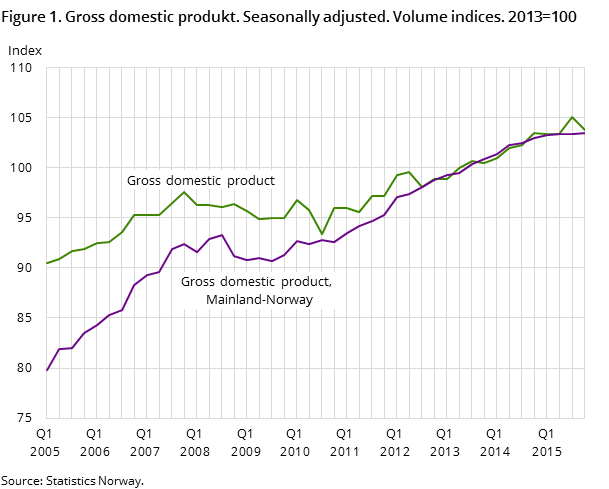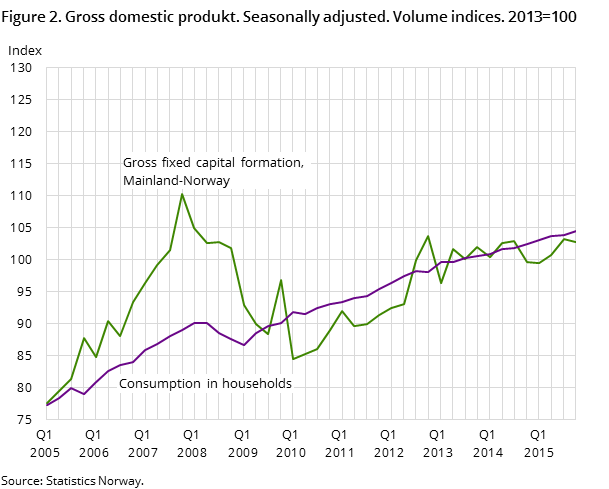Content
Published:
This is an archived release.
Continued weak growth
According to seasonally-adjusted figures, gross domestic product (GDP) for Mainland Norway rose by 0.1 per cent in the 4th quarter. On an annual basis the GDP Mainland Norway was up 1.0 per cent in 2015; the weakest annual growth rate since 2009.
| 2015 | 1st quarter 2015 | 2nd quarter 2015 | 3rd quarter 2015 | 4th quarter 2015 | |
|---|---|---|---|---|---|
| 1Figures from 2014 onwards are preliminary. | |||||
| Gross domestic product | 1.6 | -0.1 | 0.0 | 1.6 | -1.2 |
| Gross domestic product Mainland Norway | 1.0 | 0.2 | 0.2 | 0.0 | 0.1 |
| Petroleum activities and ocean transport | 3.7 | -1.2 | -0.8 | 7.8 | -5.6 |
| Final domestic use of goods and services | 0.9 | 2.4 | -0.7 | -1.4 | 0.5 |
| Final consumption expenditure of households and NPISH | 2.0 | 0.6 | 0.6 | 0.2 | 0.6 |
| Final consumption expenditure of general government | 1.8 | -0.1 | 0.4 | 0.5 | 0.3 |
| Gross fixed capital formation (GFCF) | -4.0 | 0.2 | -0.6 | -0.5 | -0.9 |
| Total exports | 2.3 | -3.0 | 0.3 | 5.6 | -2.9 |
| Total imports | 0.6 | 3.8 | -1.8 | -2.6 | 1.6 |
| Employed persons | 0.6 | 0.0 | 0.2 | 0.1 | -0.1 |
| Total hours worked | 0.6 | 0.0 | 0.1 | -0.1 | -0.2 |


Value added in the manufacturing industries decreased in all quarters in 2015, and in the fourth quarter the decline was 1.7 per cent. As in previous quarters, the development in manufacturing was affected by the reduced demand from the petroleum industry, which led to a production decline in both the goods and service providers. In some consumer-oriented manufacturing industries, such as food processing and textile industries, value added increased in the fourth quarter, but even these industries saw a decline on an annual basis.
Among producers of other types of goods the development in the fourth quarter presents a mixed picture, with a decline in volume in fisheries and electricity supply, while the growth continued in the construction industry. Based on new information, the positive trend in the construction industry through 2015 is dampened somewhat compared to previously published preliminary figures. Even on an annual basis, the volume of traditional fishing was reduced. A strong increase in prices on fish, however, resulted in a positive development in operating surplus in this industry.
Slow growth in services
In service industries excluding general government, the weak performance of the three previous quarters continued in the fourth quarter, with value added increasing by just 0.1 per cent. In 2015 as a whole, these industries grew a modest 1.0 per cent. The activity within general government increased 0.5 per cent in the fourth quarter. The annual growth rate was 1.7 per cent.
The petroleum industries were down 5.8 per cent in the fourth quarter, following a strong increase in production of natural gas in the previous quarter. This led to a decline in total GDP in the fourth quarter by 1.2 per cent. For 2015 as a whole, total GDP was up 1.6 per cent.
Increase in household consumption
Total household consumption rose by 0.6 per cent, after a weak third quarter. Consumption of goods was unchanged, while both consumption of services and resident households’ purchases abroad went up. General government consumption rose by 0.3 per cent in the fourth quarter, slightly more in local government than in central government.
Household consumption was up 2.0 per cent in 2015, while general government consumption rose by 1.8 per cent.
Decrease in investments
Preliminary figures show that the continuous fall in gross fixed capital formation (GFCF) in the petroleum extraction and pipeline industries since 2013 continued in the fourth quarter of 2015. For the year as a whole, the fall was 14.7 per cent. Services incidental to petroleum extraction also saw a strong decrease in GFCF.
GFCF in manufacturing and mining other than petroleum extraction was down 1.3 per cent from the third to the fourth quarter. The decrease in many industries was partially offset by a particular increase in manufacturing of metal.
GFCF in general government went down 2.7 per cent in the fourth quarter. Household investments in dwellings grew by 2.5 per cent, somewhat more than in the previous quarters in 2015.
GFCF in total decreased by 4.0 per cent in 2015.
Increased exports of traditional goods
Exports of traditional goods have consistently increased since the first quarter of 2014 and continued to grow in the fourth quarter of 2015. Even imports of traditional goods went up in the last quarter last year, following a decrease in the two previous quarters. Both exports and imports of services went down in the fourth quarter. In 2015 as a whole, total exports and total imports increased by 2.3 and 0.6 per cent respectively.
Lower employment
The ongoing rise in employment since 2010 came to a halt in the fourth quarter last year, when employment fell 0.1 per cent, or 3 300 persons, compared to the previous quarter. Number of hours worked also went down in the fourth quarter.
Figures for the 1st – 3rd quarter 2015 have been revised
In connection with the release of figures for the fourth quarter of 2015, new information has been incorporated for all quarters from the first quarter of 2015. The seasonally-adjusted Mainland GDP growth rates in the first, second and third quarter of 2015 have been revised down by 0.1, 0.1 and 0.2 per cent respectively.
For an overview of the revisions in the main aggregates in the last quarters see table 48.
For more information on compilation methods and seasonal adjustment practice please see About the statistics (link) and On seasonal adjustment of the quarterly national accounts (link).
For an overview of the development in the GDP of some of our trading partners please refer to OECD statistics.
Main revision of the national accountsOpen and readClose
Statistics Norway has made a main revision to the national accounts. The first results from this revision were published on 20 November 2014. The revisions are partly due to new international recommendations on national accounting and partly the result of improved methods of estimations and new sources. Read more about the main revision here.
Concepts and definitions in National AccountsOpen and readClose
For more information about definitions of the main concepts, variables and classifications in national accounts, see About the statistics, definitions.
How the figures are calculatedOpen and readClose
The sum of four quarters in the Quarterly National Accounts (QNA) makes up the preliminary annual figures until the Annual National Accounts (ANA) for year t are published in November in year t+2 and incorporated as a new base year in the QNA.
Note that in the time series in volume, the figures from the base year and onwards are fixed price figures, while data prior to the base year are chained volume figures. This implies that additivity in volume is lost prior to the base year.
Contact
-
Pål Sletten
E-mail: pal.sletten@ssb.no
tel.: (+47) 99 29 06 84
-
Ingunn Sagelvmo
E-mail: ingunn.sagelvmo@ssb.no
tel.: (+47) 40 90 26 32
-
Pia Tønjum
E-mail: pia.tonjum@ssb.no
tel.: (+47) 48 99 12 07
-
Kristian Gimming
E-mail: kristian.gimming@ssb.no
tel.: (+47) 91 88 39 06
